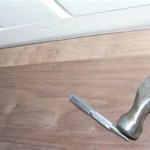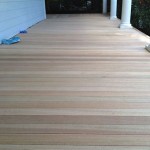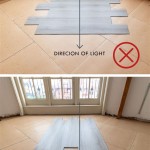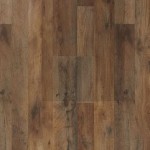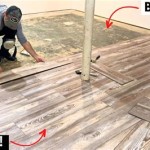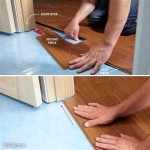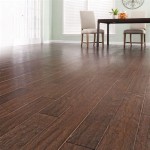Blue Wood Flooring: A Deep Dive into Aesthetics, Durability, and Application
Blue wood flooring is a distinct and increasingly popular choice for homeowners and designers seeking to create a unique and visually striking interior. Moving beyond the traditional spectrum of browns, tans, and grays, blue wood floors offer a refreshing departure, evoking a sense of tranquility, sophistication, and even a touch of the unexpected. This article delves into the various aspects of blue wood flooring, examining its aesthetic impact, the types of wood that can be used, the different shades of blue available, considerations for durability and maintenance, and finally, its suitability for different rooms and design styles.
The Aesthetic Impact of Blue Wood Flooring
The color blue possesses a wide range of psychological and visual associations. It is often linked to feelings of calmness, serenity, and stability. In interior design, blue can create a sense of spaciousness and airiness. When applied to wood flooring, these qualities are amplified, resulting in a space that feels both inviting and visually interesting. The impact of blue wood flooring is further influenced by the specific shade chosen. Lighter blues, such as pale aquamarine or sky blue, can brighten a room and create a coastal or Scandinavian-inspired aesthetic. Deeper blues, like navy or indigo, can add a touch of drama and sophistication, lending themselves well to more formal or contemporary spaces. The wood grain beneath the blue stain or finish also plays a role, adding texture and dimension to the floor. The contrast between the cool blue tone and the natural warmth of the wood grain creates a dynamic visual effect that can enhance the overall ambiance of a room.
Furthermore, blue wood flooring acts as a neutral backdrop, allowing other design elements in the room to stand out. Furniture, artwork, and textiles in complementary colors, such as whites, creams, grays, yellows, and even oranges, can be used to create a balanced and harmonious palette. The strategic use of contrasting colors can further enhance the visual interest of the space, creating a dynamic and engaging environment.
The aesthetic impact also depends on the finish applied to the blue wood floor. A matte finish will create a more subtle and understated look, while a glossy finish will reflect light and add a touch of glamour. The choice of finish should be carefully considered based on the desired aesthetic and the overall style of the room.
Types of Wood Suitable for Blue Staining and Finishing
The choice of wood species is crucial for achieving the desired look and ensuring the longevity of blue wood flooring. Some wood species are more receptive to staining and finishing than others, and their natural grain patterns will also influence the final appearance. Hardwoods, such as oak, maple, and ash, are generally considered the best options for wood flooring due to their durability and ability to withstand heavy foot traffic. However, each species possesses unique characteristics that make it suitable for different applications and aesthetic preferences.
Oak, with its prominent grain pattern and inherent hardness, is a popular choice for blue wood flooring. Red oak has a reddish-brown hue and a more open grain, while white oak is lighter in color and has a tighter grain. Both types of oak accept stain well, but the choice between them depends on the desired level of grain definition and the specific shade of blue being used. Maple, known for its smooth, even grain and light color, is another excellent option. It provides a clean and contemporary look, allowing the blue stain to be the primary focus. Ash, similar to oak in hardness, offers a slightly more subtle grain pattern and a lighter color, making it a versatile choice for various blue hues.
Softwoods, such as pine and fir, can also be used for blue wood flooring, but they are generally less durable and more prone to dents and scratches. However, they can be a more affordable option and are often used in rustic or informal settings. When using softwoods, it is important to choose a durable finish and take extra care to protect the floor from damage. The natural knots and imperfections in softwoods can add character to the flooring, but they can also affect the uniformity of the blue stain. Careful consideration should be given to the desired aesthetic and the expected level of traffic before choosing a softwood for blue wood flooring.
In addition to solid wood, engineered wood flooring is also a viable option for blue finishes. Engineered wood consists of a thin layer of hardwood veneer bonded to a core of plywood or fiberboard. This construction provides greater stability and resistance to moisture and warping compared to solid wood, making it suitable for use in areas with high humidity or temperature fluctuations. The hardwood veneer can be stained and finished in the same way as solid wood, allowing for a wide range of blue hues and finishes. Engineered wood flooring is often easier and less expensive to install than solid wood, making it a popular choice for budget-conscious homeowners.
Shades of Blue: From Coastal Cool to Deep Indigo
The spectrum of blue hues available for wood flooring is vast, ranging from light and airy pastels to deep and saturated tones. The specific shade of blue chosen will have a significant impact on the overall aesthetic of the room. Lighter blues, such as sky blue, powder blue, and aquamarine, evoke a sense of tranquility and airiness, making them ideal for creating a coastal or Scandinavian-inspired look. These shades can brighten a room and create a feeling of spaciousness, making them well-suited for smaller or darker spaces.
Medium blues, such as denim blue, steel blue, and cerulean, offer a more versatile option, working well with a variety of design styles. These shades can add a touch of sophistication and elegance to a room while still maintaining a sense of calmness and serenity. They pair well with both light and dark furniture and can be used to create a balanced and harmonious palette.
Deeper blues, such as navy blue, indigo, and sapphire blue, create a more dramatic and sophisticated look. These shades can add depth and richness to a room, making them ideal for formal living rooms, dining rooms, or bedrooms. They pair well with metallics, such as gold and silver, and can be used to create a luxurious and opulent atmosphere. Deeper blues can also be used to create a moody and intimate setting, making them well-suited for media rooms or home offices.
The intensity of the blue stain will also affect the final appearance of the flooring. A lighter stain will allow more of the wood grain to show through, creating a more natural and rustic look. A darker stain will obscure the wood grain, creating a more uniform and contemporary look. The choice between a lighter and darker stain depends on the desired level of grain definition and the overall style of the room.
Beyond solid blue, other techniques can be employed to create unique effects. Distressed finishes, for example, can add character and charm to blue wood flooring, creating a vintage or reclaimed look. Limewashing or whitewashing can create a softer, more muted blue, adding a touch of rustic elegance. The possibilities are numerous, allowing for a high degree of personalization and customization.
Durability and Maintenance Considerations
The durability of blue wood flooring depends on several factors, including the type of wood used, the finish applied, and the level of traffic the floor receives. Hardwoods, such as oak, maple, and ash, are generally more durable than softwoods, such as pine and fir. However, even hardwoods can be susceptible to scratches, dents, and wear and tear if not properly protected. The finish applied to the flooring plays a crucial role in protecting the wood from damage. Polyurethane finishes are known for their durability and resistance to scratches and water damage, making them a popular choice for high-traffic areas. Oil-based finishes offer a more natural look and feel but may require more frequent maintenance. Water-based finishes are low in VOCs and environmentally friendly but may not be as durable as other options.
Regular maintenance is essential for preserving the beauty and extending the lifespan of blue wood flooring. This includes sweeping or vacuuming regularly to remove dirt and debris, which can scratch the finish. Spills should be cleaned up immediately to prevent staining or water damage. Avoid using harsh chemicals or abrasive cleaners, as these can damage the finish. Instead, use a pH-neutral cleaner specifically designed for wood floors. It is also recommended to use mats or rugs in high-traffic areas to protect the flooring from wear and tear.
Depending on the level of traffic and the type of finish, blue wood flooring may need to be refinished periodically. Refinishing involves sanding down the existing finish and applying a new coat of stain and finish. This can restore the flooring to its original beauty and extend its lifespan. The frequency of refinishing depends on the wear and tear the floor receives. High-traffic areas may need to be refinished every few years, while low-traffic areas may only need to be refinished every 10-15 years.
Protecting the floor from excessive moisture is also crucial. While engineered wood provides better moisture resistance, both solid hardwood and engineered wood can still be damaged by prolonged exposure to water. Avoid using excessive water when cleaning, and ensure that any spills are cleaned up promptly. Consider using dehumidifiers in areas with high humidity, and take steps to prevent water leaks from appliances or plumbing. By taking these precautions, you can help to ensure that your blue wood flooring remains beautiful and durable for years to come.
Suitability for Different Rooms and Design Styles
Blue wood flooring is a versatile option that can be incorporated into a variety of rooms and design styles. Its unique aesthetic can enhance the overall ambiance of a space, creating a sense of tranquility, sophistication, or even a touch of whimsy. In living rooms, blue wood flooring can create a calming and inviting atmosphere, making it ideal for relaxation and entertaining. Lighter blues can brighten a room and create a coastal or Scandinavian-inspired look, while deeper blues can add a touch of drama and sophistication. The choice of furniture and accessories will further enhance the overall style of the room.
In bedrooms, blue wood flooring can create a serene and restful environment. Lighter blues are particularly well-suited for bedrooms, as they promote relaxation and sleep. Consider pairing blue wood flooring with soft textiles and muted colors to create a cozy and inviting space. In bathrooms, blue wood flooring can add a touch of spa-like luxury. However, it is important to choose a durable finish and take extra care to protect the floor from moisture. Engineered wood flooring is often a better choice for bathrooms due to its greater resistance to moisture and warping.
In kitchens, blue wood flooring can add a pop of color and personality to a traditionally utilitarian space. However, kitchens are high-traffic areas that are prone to spills and accidents, so it is important to choose a durable finish and take extra care to protect the floor from damage. Consider using mats or rugs in front of the sink and stove to protect the flooring from water and food spills. Dining rooms can also benefit from the unique aesthetic of blue wood flooring. Deeper blues can add a touch of elegance and sophistication to a formal dining room, while lighter blues can create a more casual and inviting atmosphere.
Blue wood flooring can also be incorporated into a variety of design styles. It is a natural fit for coastal and nautical styles, where it evokes the colors of the ocean and sky. It can also be used to create a Scandinavian-inspired look, with its clean lines and minimalist aesthetic. In contemporary spaces, blue wood flooring can add a touch of drama and sophistication. It can also be used to create a rustic or farmhouse-inspired look, with its distressed finishes and natural wood grain. Ultimately, the suitability of blue wood flooring for a particular room or design style depends on the specific shade of blue chosen, the type of wood used, the finish applied, and the overall aesthetic of the space.

Herringbone Midnight Blue Rhodium Floors
My Color Washed Living Room Floor A Beautiful Mess

On Trend Blue Tone Flooring Brings A Natural Feel To Your Home The Money Pit

Ocean Blue Oak Engineered Wood Flooring Timber Zone

High Variation Vinyl Flooring Floor Decor Wood Look Tile Planks Blue

Home Decorators Collection Peyor Blue 12 Mil X 7 In 48 Waterproof Lock Luxury Vinyl Plank Flooring 23 8 Sqft Case Vtrhdpeyoak7x48 The Depot

Are Hardwood Floors Considered A Pattern

Blue Washed Wood Flooring Floor Pattern Engineered Floors Oak Mosaic

Rustic Oiled Oak Flooring Solid Planks Lavender Floorings11 F2

Blue Flooring At Com
Related Posts

